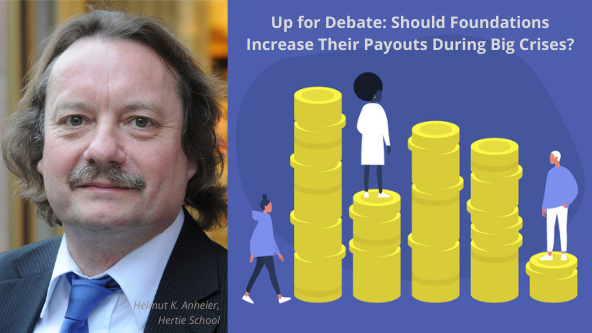
In his thoughtful essay, Larry Kramer argues that “there is no one right answer to the question whether to pay out more during a financial crisis” and that the optimal expenditure amount “depends on balancing the needs of present and future beneficiaries and so varies depending on a funders’ goals and objectives.” At first reading, these statements seem to proclaim the obvious. Upon further reflection, we realize that the argument says little about the possibility of wrong, misguided, or irrelevant answers, even though there may not be a single “right” one. Additionally, the emphasis on the goals and objectives of the funders fails to account for the needs of the beneficiaries
The funder-centric view that dominates the essay is not surprising, given that Kramer is the head of one of the world’s largest foundations. As a whole, however, the essay leaves one to wonder what the actual problem is, other than to respond to critiques of how Kramer is managing the William and Flora Hewlett Foundation’s endowment during the COVID crisis. This is fine, of course, but the essay does not address the underlying issues and neglects much of the context needed to come to a richer understanding of what foundations can contribute in times of crisis. In my view, Kramer should have asked: Do conventional grantmaking foundations offer the right instruments for times of crisis or are there alternative approaches?

To explore this question, I will try to advance three arguments: first, that the applicability of Kramer’s statements depends on the purpose and role foundations see for themselves; second, that the payout rate and how much of their endowment foundations could or should use is ultimately about donor/funder versus government control; and third, that the current debate about foundation spending during times of crisis neglects the much more important contributions of others, in particular government.
Let’s look at foundation purpose and roles first. It is useful to separate what foundations want to achieve (purpose) and how they intend to do it (approach) from what they actually do (roles). Failing to separate these three factors leads easily to over-generalizations and fails to appreciate the differentiated field of modern philanthropy.
A foundation has three basic purposes: bringing about change, providing protection, and offering immediate relief. A foundation can bring about change by promoting structural reforms of existing systems or supporting innovations to bring about new ones by helping give voice, fostering recognition of new needs, and seeking empowerment for the socially excluded. For example, during a crisis a foundation can advance urgent policy changes by supporting advocacy networks.
Providing protection refers to foundations whose objective is to defend and support certain communities or practices, shield traditions or works of art, or seek to maintain the status quo. For example, foundations seeking to protect art objects from being looted during civil wars or music lessons to students affected by budget cuts to arts education. Finally, the purpose of offering relief is to alleviate suffering and meet needs, often by providing shelter or medicines, feeding the hungry, or helping families in distress.
These three purposes can be pursued in different ways. Often, foundations enable third parties, usually by providing grants and other support to nonprofit organizations. They can also set up organizations dedicated to the cause and operating specific programs. Or they can use a mixture of both. These three purposes account for the three conventional types of foundations: grantmaking foundations, operating foundations, and mixed foundations. However, as I will point out below, there are new forms of philanthropy that allow for much greater donor discretion in managing endowments and spending.
In pursuing their purpose and through their activities, foundations can assume different roles as they seek to attain their goals. They can be innovators and promotors of innovation by, for example, supporting new ways to avoid or reduce homelessness in times of crisis. They can play a complimentary role next to other providers by helping provide food and shelter for the homeless alongside local government. They can play a substitution role by taking on functions previously supplied by government, such as providing food and shelter for the homeless in the face of government cutbacks. Finally, they can be builders and create something new, for example by funding the construction of low-income housing itself.
Note that the various combinations of purpose, approach, and role imply different responses in times of crisis. Some foundations are more affected than others. For example, a foundation contributing money to build a museum will be largely shielded from the crisis, whereas a foundation supporting innovations in social service delivery during a pandemic will be greatly exposed to the crisis. Some will also face more pressure on resources than others. A grantmaking foundation in a substitution role will face greater demands to increase spending than a foundation that complements and coordinates with other foundations, corporations, or government agencies.
These observations reveal that Kramer is really only referring to a subset of foundations: those affected by the crisis and facing resource pressures. Here, he usefully points out the trade-off between short-term spending (by assuming alleviation purposes) and longer-term purposes (by solving complex social problems as an innovator that works with third parties). To address this dilemma, foundations have three options they can follow separately or in combination: using reserve funds accumulated prior to the crisis (which the Hewlett Foundation has done), mobilizing parts of their endowment, and looking for leverage.
Most foundations will have insufficient reserve funds to allow major changes to their grantmaking, which brings us to the issue of the payout requirement. The 5 percent rate is arbitrary. It was set decades ago and under very different economic and political circumstances, and when the foundation world was much smaller. Why not 1 percent, to cover the public cost of monitoring tax-exempt entities? Why not 3 percent, so foundations can more easily build endowments? Or why not 8 or 10 percent, to encourage them to spend? The answer depends on how much flexibility the legislature, and ultimately the taxpayer, wants foundations to have, and indeed, how much of a lifeline.
The payout rate is therefore political and about control: Should government regulate how much foundations spend, and relative to what? Should government go further and either require or incentivize foundations to spend more during times of crisis, or to issue debt for mobilizing additional resources in the short-term? And, should the donor maintain greater control over the endowment, being able to overrule foundation boards, presidents, and program officers?
The centrality of control over resources and their purpose goes beyond the payout rate and speaks to the suitability and attractiveness of the endowed grantmaking foundation in principle. Kramer refers to the new ‘gilded age’ and a new generation of funders. Yet significant funds that would normally have found their way into conventional grantmaking foundations are increasingly allocated to different approaches, exemplified by The Chan Zuckerberg Initiative or the many thousands of donor-advised funds. They prefer vehicles and instruments that allow for greater control and discretion for donors in changing purpose, approach, and role quickly as well as shifting philanthropic dollars with ease—something the independent endowed foundations limits.
Are private foundations like Hewlett a model of the past? If so, a key question, which Kramer does not address directly is: Should endowed foundations established in perpetuity be encouraged to become spend-down foundations, at least for some limited period of time? Should they be able to transform into new entities akin to the Zuckerberg-type of foundation?
The increase in the number of time-limited, spend-down, or spending-out foundations is a response to a combination of four largely independent factors: having cash flows commensurate with the mission and a set of objectives that involve shorter time frames; the desire to honor donor intent in a timely fashion; dealing with the rise of performance and impact measures; and the growth in the number of smaller foundations with limited endowments. Note that these factors can be more acute in times of crisis. For example, can we make sure that cash flows are adequate to make a difference in how the crisis is managed by focusing on immediate relief? Can we mobilize ‘sunk capital’ in thousands of smaller foundations while realizing donor intent? Thinking of how foundations can react in periods of crisis through the lens of time-limited foundations or new instruments and vehicles could encourage many innovations.
Finally, there is the assumption in Kramer’s essay that foundations are major players when it comes to crisis response. I would argue that the foundations Kramer writes about—those exposed to the crisis—are simply not set up to do so by virtue of their basic construction as a legal form. Moreover, the scale of the current crisis is too great for even the largest foundations to have either short- or long-term impact other than in targeted fields of intervention. The funds foundations can command even when using more or all of their endowment pale in comparison to the massive rescue packages already disbursed and being discussed in Washington, Brussels, London, Berlin, and other capitals.
Accordingly, these foundations are well-advised to choose their intervention points carefully and seek strategic cooperation with other organizations and agencies. This can be a leverage model to mobilize resources, a rapid response unit organized as a public-private partnership, an agreement to focus on a specific set of needs that a government agency may struggle to meet on time, or an advocate for innovations taking place in an effort to encourage change. Whichever purposes and roles foundations assume in responding to a crisis, they should do so with a certain humility knowing that they are an important, but not the primary actor.
Kramer's essay is a critical and constructive contribution to assess the role of foundations in periods of crisis. Yet, it is also largely ‘inside the box,’ assuming a certain set of purposes, approaches, and roles exemplified by relatively large grantmaking foundations. But many of the most important developments in philanthropy may not come from such traditional players. As any crisis tends to lay bare some of the underlying issues and dilemmas, it also points to innovations and changes. Could it be that without intending to do so, Kramer’s passionate essay demonstrates the limits of conventional foundations and points to the need for alternative philanthropic ways and means?
Support SSIR’s coverage of cross-sector solutions to global challenges.
Help us further the reach of innovative ideas. Donate today.
Read more stories by Helmut K. Anheier.

